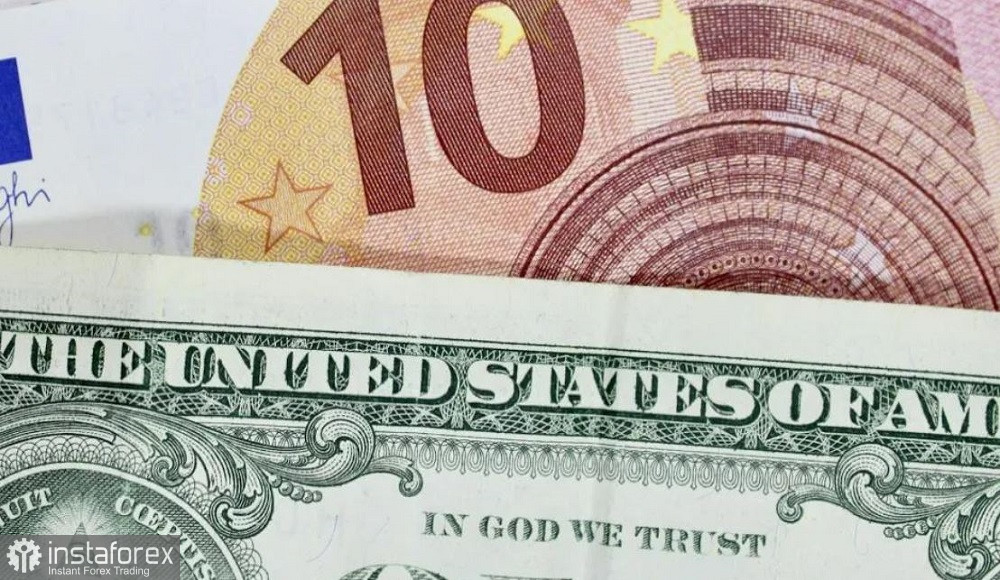At the start of the new trading week, the EUR/USD pair returned to the range of the 0.9 figure after a sharp decline on Friday. The pair plummeted by more than 100 pips in just a few hours. Such dynamics seemed logical, as the fundamental background did not exactly boost the dollar.
The Federal Reserve expressed readiness for monetary easing, while the European Central Bank maintained a combat-ready stance, assuring markets that interest rates would remain unchanged, at least for the next six months. Thanks to the rate discrepancy between the Fed and ECB rates, the bulls once again tested the 1.10 figure. However, the next attempt failed again: on Friday, sellers took the initiative, pulling the price to the 0.8 figure. This happened amid weak PMI data and the so-called "Friday factor": after a sharp price surge, traders started to take profits, putting an end to the bullish momentum and triggering a bearish pullback.

But there are no substantial grounds for developing a sustained downward movement — primarily due to the emerging divergence between the Fed and the ECB. This is a very powerful fundamental factor that plays, if not on the bulls' side (for now), then certainly against the bears.
On the other hand, the buyers also need help to build an uptrend. They need another informational trigger that will not only allow them to test the resistance level at 1.1020 (the upper line of the Bollinger Bands indicator on the daily chart) but also to settle above this target, in the area of the 1.10 figure.
The problem is that soon (starting next week), the currency market will fall into a lethargic sleep characteristic of the Christmas-New Year period. The last major economic report for EUR/USD will be published this Friday, December 22. On this day, the main Personal Consumption Expenditure index will be released in the U.S.—one of the key inflation indicators closely monitored by members of the Fed.
Take note that other equally important inflation indicators published this month (Consumer Price Index and producer price index) reflected a slowdown in inflation in November. Now it's the turn of the core PCE price index. According to forecasts, this indicator will demonstrate a downward trend again in November, falling to 3.4% YoY. In this case, the index will hit a multi-month low— the last time it was at this level was over two years ago in May 2021. The core PCE index has been consistently declining for the past three months (August, September, October), and the Fed has significantly softened its position thanks to this factor.
In the final press conference, Fed Chair Jerome Powell said that the current tightening cycle of monetary policy has "most likely" ended, bringing the discussion of interest rate cuts to the forefront. Considering that Friday's inflation report will be the last significant release of the year, there is no doubt that it will trigger strong volatility among dollar pairs, especially if it falls into the "red zone" (according to some estimates, it could fall to 3.2% or even 3.1%).
The market is already pricing in the first rate cut at the March meeting. The probability of a 25-point cut is currently estimated at 66%. Even if the core PCE index comes in line with forecasts (let alone the red zone), this probability will increase to 70-80%, mounting pressure on the greenback.
It's also worth noting that the probability of a rate cut to 5.0% in May is at 59%. Here, it's essential to recall the Fed's updated dot plot, according to which most Committee members expect a 75-basis-point rate cut in 2024.
Such a fundamental background will not provide a significant boost to the dollar. On Monday, EUR/USD traders virtually ignored the IFO institute's report, even though all components were in the red zone (for instance, the Business Climate Index in Germany fell to 86.4 points in December, versus the 87.8 forecasts by analysts).
This indicates that the EUR/USD pair is primarily oriented towards the greenback's behavior, while the euro's dynamics play a secondary role. In turn, the Fed's dovish position and the decline in Treasury yields are playing a role against the greenback.
From a technical standpoint, the pair remains between the middle and upper lines of the Bollinger Bands indicator on the daily chart, as well as above all lines of the Ichimoku indicator, which still shows a bullish Parade of Lines signal. All of this suggests that you should consider long positions. Do so after the pair surpasses the 1.0950 mark (the Tenkan-sen line on the 4-hour chart). The main target of the upward movement is located at the 1.1020 mark (the upper Bollinger Bands line on the 4H and 1D timeframes).
 English
English 
 Русский
Русский Bahasa Indonesia
Bahasa Indonesia Bahasa Malay
Bahasa Malay ไทย
ไทย Español
Español Deutsch
Deutsch Български
Български Français
Français Tiếng Việt
Tiếng Việt 中文
中文 বাংলা
বাংলা हिन्दी
हिन्दी Čeština
Čeština Українська
Українська Română
Română

